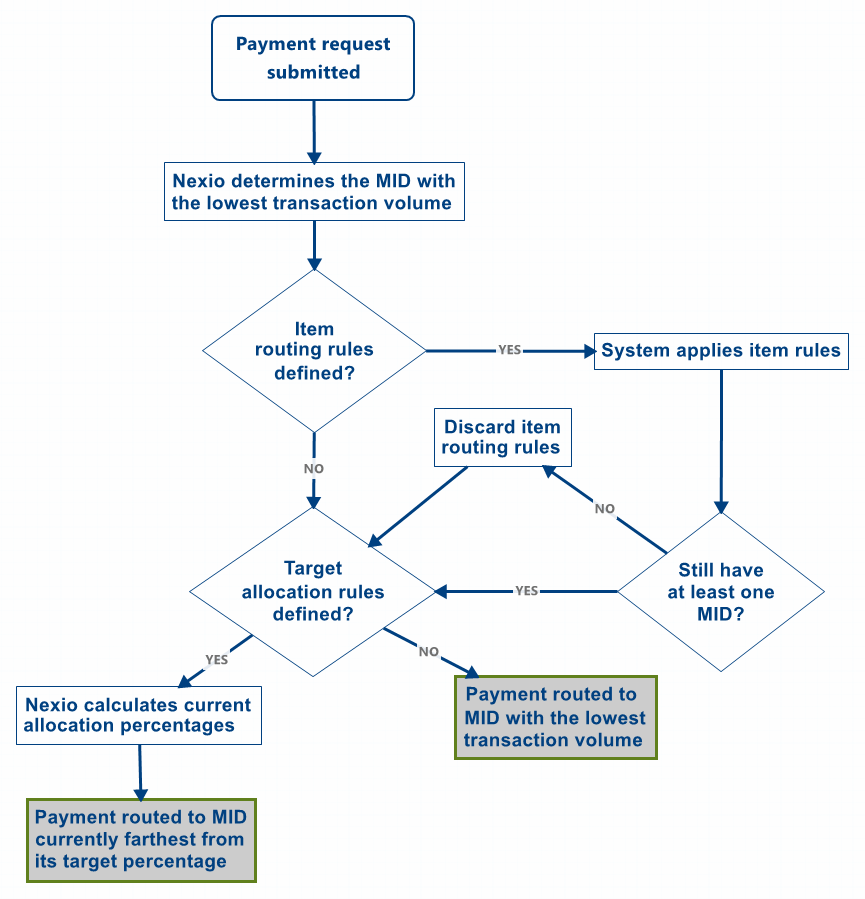How do I use both item routing and target allocation together?
You can set up rules for both item routing and target allocation to create a complex payment routing flow when you have more than one merchant ID (MID).
Before setting up rules, see the Important Notes in the following topics:
- How do I keep a relationship active at a specific transaction percentage?
- How do I route all transactions with a specific item to a relationship?
To set up payment routing by item and target allocation
-
Complete steps 1-9 in Setting up payment routing by target allocation
-
Complete steps 5-10 in Setting up payment routing by item
What happens after you set up both target allocation and item routing?
After you complete the steps for creating rules for both target allocation and item routing, the following process happens for each transaction (using 'CBD' as the item for routing):
-
A consumer adds an item to the shopping cart where the
typeis 'CBD' and submits payment.For example,
data.cart.items[1].typeequals 'CBD' and the transaction currency is 'USD'. -
The Nexio system determines the merchant account (MID) with the lowest monthly gross of authorized transactions (also known as transaction volume).
For example, suppose MID #1, MID #2, and MID #3 can support the currency and MID #4 does not. Only the first 3 are considered.
Then, if MID #1 has a current volume of $4,500, MID #2 is $10,300, and MID #3 is $8,000, the system prioritizes them as follows:
- MID #1
- MID #3
- MID #2
In this case, MID #1 has the lowest transaction volume.
-
The system checks whether there are any item routing rules with any of the applicable MIDs.
For example, MID #1 has a rule about the type being 'CBD', MID #2 has a rule about the description containing 'CBD', and MID #3 has a rule about the type and item containing 'CBD'.
If there are not any item routing rules, the system skips to step 5 in this sequence.
-
Based on the items in the cart and the item routing rules, the system identifies which of the MIDs can process the transaction.
For the following examples, MID #1 has a rule about the type being 'CBD', MID #2 has a rule about the description containing 'CBD', and MID #3 has a rule about the type and item containing 'CBD'.
Example 1:
Filtering when only type is 'CBD' The MIDs would be prioritized as follows: - MID #1Example 2:
Filtering when both type and item are 'CBD' The MIDs would be prioritized as follows: - MID #1 - MID #3Example 3:
Filtering when type is 'CBD' and description and item both contain 'CBD' The MIDs would be prioritized as follows: - MID #1 - MID #3 - MID #2Example 4:
If applying the item routing rules results in no possible MIDs to process the transaction, the system ignores the rules.
Filtering when description is exactly 'CBD' The list is empty, therefore the system removes the rule filtering, resulting in the following priorities for the MIDs: - MID #1 - MID #3 - MID #2 -
The system checks to see if there are target allocation rules that match for this transaction.
If there are not any target allocation rules, the system skips to step 7 in this sequence.
-
The system takes the target allocations and re-sorts the list so that the MID that is farthest away from its target allocation is at the top.
For the following examples, the target allocation is 10% for MID #1, 90% for MID #2, and 0% for MID #3.
Example 1: Current total transaction volume of $5,600.
MID #1 has a current volume of $300 and 10% allocation, so it is at 5.4% and thus 4.6% away from the target for the month. MID #2 has a current volume of $4,800 and 90% allocation, so it is at 85.7% and thus 4.3% away from the target for the month. MID #3 has a current volume of $500 but 0% target allocation, so it is at 8.9%. However, the target is 0%, so no transactions will go to this MID. The MIDs would be prioritized as follows: - MID #1 - MID #2 - (MID #3)
Example 2: Current total transaction volume of $22,800MID #1 has a current volume of $4,500 and 10% allocation, so it is at 19.7% currently and thus 9.7% over the target for the month. MID #2 has a current volume of $10,300 and 90% allocation, so it is at 45.2% and thus 44.8% away from the target for the month. MID #3 has a current volume of $8,000 but 0% target allocation, so it is at 35.1%. However, the target is 0%, so no transactions will go to this MID. The MIDs would be prioritized as follows: - MID #2 - MID #1 - (MID #3) -
The system routes the payment to the MID at the top of the list.
The following image shows a high-level view of the payment flow from above for when you are using both target allocation and item routing with multiple MIDs.

Target and Item Flow
Updated 4 months ago
